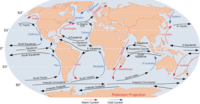
Photo from wikipedia
The individual impact of North Atlantic and Pacific Ocean Western Boundary Currents (OWBCs) on the tropospheric circulation has recently been studied in depth. However, their simultaneous role in shaping the… Click to show full abstract
The individual impact of North Atlantic and Pacific Ocean Western Boundary Currents (OWBCs) on the tropospheric circulation has recently been studied in depth. However, their simultaneous role in shaping the hemisphere-scale wintertime troposphere/stratosphere-coupled circulation and its variability have not been considered. Through semi-idealized Atmospheric General-Circulation-Model experiments, we show that the North Atlantic and Pacific OWBCs jointly maintain and shape the wintertime hemispheric circulation and its leading mode of variability Northern Annular Mode (NAM). The OWBCs energize baroclinic waves that reinforce quasi-annular hemispheric structure in the tropospheric eddy-driven jetstreams and NAM variability. Without the OWBCs, the wintertime NAM variability is much weaker and its impact on the continental and maritime surface climate is largely insignificant. Atmospheric energy redistribution caused by the OWBCs acts to damp the near-surface atmospheric baroclinicity and compensates the associated oceanic meridional energy transport. Furthermore, the OWBCs substantially weaken the wintertime stratospheric polar vortex by enhancing the upward planetary wave propagation, and thereby affecting both stratospheric and tropospheric NAM-annularity. Whereas the overall impact of the extra-tropical OWBCs on the stratosphere results mainly from the Pacific, the impact on the troposphere results from both the Pacific and Atlantic OWBCs.
Journal Title: Scientific Reports
Year Published: 2019
Link to full text (if available)
Share on Social Media: Sign Up to like & get
recommendations!